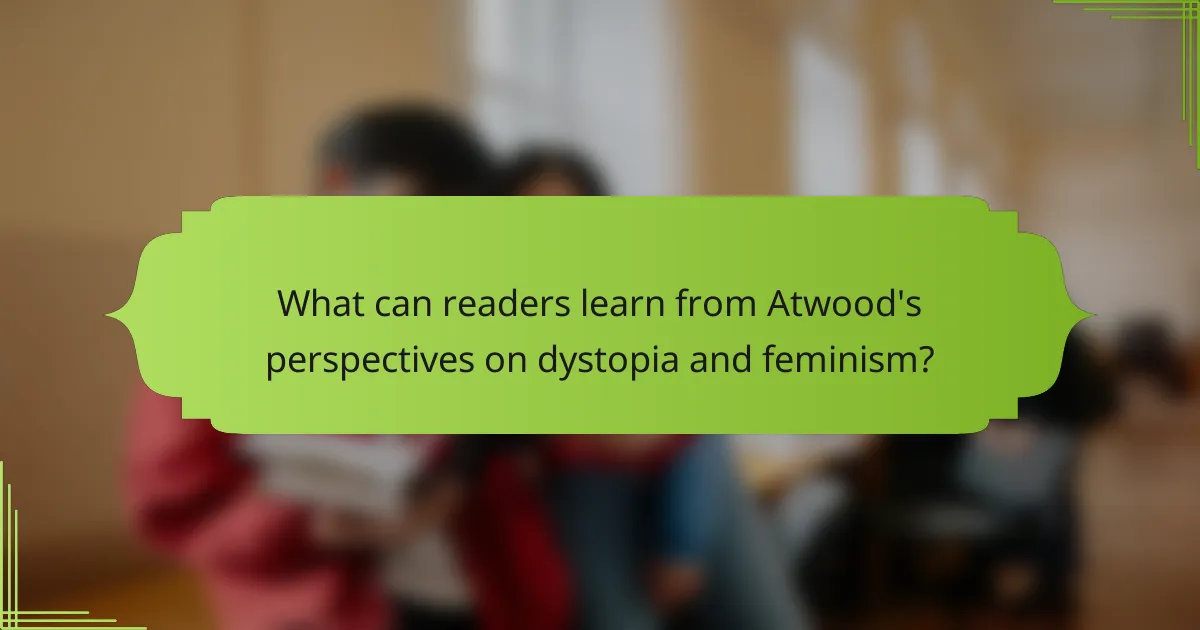Margaret Atwood’s works provide critical insights into dystopian themes, feminist perspectives, and social commentary. Her narratives explore environmental degradation, gender inequality, and the resilience of women in oppressive societies. Atwood’s critical acclaim highlights her unique narrative style, blending speculative fiction with pressing contemporary issues. This article delves into the complexities of her storytelling and the impact of her literary contributions.

What are the key themes in Margaret Atwood’s dystopian works?
Margaret Atwood’s dystopian works explore themes of environmental degradation, gender inequality, and authoritarianism. These themes reflect societal anxieties and challenge traditional narratives. Atwood’s feminist perspectives highlight women’s resilience and agency in oppressive settings. Her critical acclaim stems from her ability to blend speculative fiction with social commentary, creating thought-provoking narratives that resonate with contemporary issues.
How does Atwood portray power dynamics in her narratives?
Atwood portrays power dynamics as complex and often oppressive, highlighting the interplay of gender, authority, and societal structures. Her narratives frequently depict women navigating patriarchal systems, revealing the struggles for autonomy and agency. For example, in “The Handmaid’s Tale,” power manifests through enforced subjugation and control, illustrating the consequences of extreme authority. This portrayal emphasizes the unique attribute of Atwood’s work: the exploration of dystopian societies as reflections of contemporary issues. Her critical acclaim stems from this nuanced examination of power, resonating with readers who recognize its relevance today.
What role does environmentalism play in her storytelling?
Environmentalism plays a crucial role in Margaret Atwood’s storytelling, shaping her narratives and themes. Her works often explore the consequences of environmental degradation, reflecting on humanity’s relationship with nature. For example, in “The Handmaid’s Tale,” Atwood illustrates a dystopian future where ecological collapse influences societal structures. This unique attribute of intertwining environmentalism with feminist perspectives deepens her critique of power dynamics and survival. Atwood’s storytelling serves as a warning, urging readers to consider the implications of environmental neglect.
How do her characters reflect societal issues?
Margaret Atwood’s characters often embody societal issues, highlighting themes of gender inequality, environmental degradation, and authoritarianism. For instance, in “The Handmaid’s Tale,” the protagonist represents the struggle against a patriarchal society. Atwood’s nuanced portrayals provoke critical discussions about contemporary social dynamics. Her characters serve as mirrors reflecting real-world concerns, making her work profoundly relevant. Through their experiences, Atwood critiques societal norms and urges readers to confront uncomfortable truths.

What feminist perspectives are prevalent in Atwood’s writing?
Margaret Atwood’s writing features feminist perspectives that challenge patriarchal structures and explore women’s autonomy. Her works often reflect themes of power, identity, and resistance. For instance, “The Handmaid’s Tale” critiques reproductive control and societal oppression, while “Oryx and Crake” examines the consequences of environmental degradation and gender roles. Atwood’s characters frequently navigate complex relationships, highlighting the intersection of gender and power dynamics. These feminist themes resonate with contemporary discussions on women’s rights and social justice, establishing Atwood as a pivotal voice in modern literature.
How does Atwood challenge traditional gender roles?
Margaret Atwood challenges traditional gender roles by portraying women as complex, powerful figures in her narratives. She subverts stereotypes, illustrating women’s resilience and agency in dystopian settings. Her characters often defy societal expectations, showcasing diverse identities and experiences. For instance, in “The Handmaid’s Tale,” women navigate oppressive systems, revealing the strength found in solidarity and rebellion. Atwood’s feminist perspectives encourage readers to question and critique established norms, promoting a deeper understanding of gender dynamics.
What influence does intersectionality have in her characters’ experiences?
Intersectionality significantly shapes Margaret Atwood’s characters by highlighting their diverse experiences and struggles. Atwood’s characters often navigate complex identities influenced by gender, race, class, and sexuality. This multifaceted approach allows readers to understand how systemic inequalities intersect, affecting their lives and choices. For example, in “The Handmaid’s Tale,” the protagonist’s experience as a woman in a patriarchal society is exacerbated by her socio-economic status, illustrating unique vulnerabilities. Atwood’s exploration of these intersecting identities deepens the emotional impact of her narratives, fostering critical discussions on societal structures.

How has Margaret Atwood’s work been received critically?
Margaret Atwood’s work has received widespread critical acclaim for its innovative dystopian themes and feminist perspectives. Her novels, particularly “The Handmaid’s Tale” and “Oryx and Crake,” are celebrated for their profound social commentary. Critics often highlight her ability to blend speculative fiction with pressing contemporary issues, making her narratives both relevant and thought-provoking. Atwood’s unique attribute lies in her mastery of language and her ability to create compelling, multi-dimensional characters. As a result, she has garnered numerous awards, including the Booker Prize, further solidifying her status as a leading voice in literature.
What awards and honors has she achieved throughout her career?
Margaret Atwood has received numerous awards and honors throughout her career. Notable among these are the Booker Prize, the Arthur C. Clarke Award, and the Golden Booker Prize. Atwood’s unique contributions to literature have earned her recognition as a pivotal figure in feminist literature and dystopian fiction. Her works have been translated into over 40 languages, further amplifying her critical acclaim globally.
How do literary critics assess her impact on contemporary literature?
Literary critics assess Margaret Atwood’s impact on contemporary literature through her innovative narrative techniques and exploration of feminist themes. Her works, such as “The Handmaid’s Tale,” challenge societal norms and provoke critical discourse. Critics highlight her ability to blend dystopian elements with real-world issues, making her a significant voice in modern literature. Atwood’s unique attribute lies in her foresight regarding gender and environmental issues, which resonates with current global concerns. Her critical acclaim is evidenced by numerous awards, including the Booker Prize, solidifying her status as a pivotal figure in literature.

What are the unique attributes of Atwood’s narrative style?
Margaret Atwood’s narrative style features unique attributes that include intertextuality, nonlinear storytelling, and a strong focus on psychological depth. Her use of dystopian settings often critiques societal norms and gender roles. Atwood’s prose blends poetic language with stark realism, enhancing emotional resonance. The incorporation of speculative elements allows her to explore complex themes, making her narratives both engaging and thought-provoking.
How does she blend genres to create her distinctive voice?
Margaret Atwood blends genres by combining dystopian themes with feminist perspectives, creating a distinctive voice. Her works often critique societal norms while exploring human resilience. This fusion enhances her narratives, engaging readers through complex characters and thought-provoking plots. Atwood’s unique attribute lies in her ability to intertwine speculative fiction with social commentary, making her narratives both imaginative and relevant. Her critical acclaim stems from this innovative approach, resonating with diverse audiences and sparking essential conversations.
What techniques does she use to build suspense and tension?
Margaret Atwood employs various techniques to build suspense and tension in her narratives. She uses foreshadowing to hint at future events, creating an atmosphere of anticipation. Atwood often utilizes unreliable narrators, which adds layers of uncertainty and intrigue. Her vivid imagery and detailed settings immerse readers, heightening emotional stakes. Additionally, she incorporates pacing variations, alternating between slow, reflective moments and rapid, tension-filled sequences to maintain engagement. Through these methods, Atwood effectively captivates her audience, making her dystopian visions resonate deeply.

Which rare elements can be found in Atwood’s lesser-known works?
Margaret Atwood’s lesser-known works feature rare elements such as unconventional narrative structures, intricate world-building, and deep psychological insights. These attributes enrich her exploration of dystopian themes and feminist perspectives. In “The Blind Assassin,” for instance, Atwood employs a layered storytelling technique that intertwines multiple narratives, showcasing her unique approach to character development and thematic depth.
What themes emerge in her poetry compared to her fiction?
Margaret Atwood’s poetry often emphasizes emotional depth and personal experience, while her fiction explores broader societal issues. In her poetry, themes of identity and nature emerge prominently. In contrast, her fiction frequently delves into dystopian settings and feminist critiques. Both forms showcase her critical acclaim and unique narrative style.
How do her essays contribute to her overall literary legacy?
Margaret Atwood’s essays significantly enhance her literary legacy by exploring complex themes and social critiques. Her essays delve into dystopian narratives, feminist ideologies, and environmental concerns, reflecting her unique perspective. Atwood’s critical acclaim stems from her ability to engage readers with thought-provoking ideas, reinforcing her status as a leading literary voice. Through these essays, she solidifies her influence on contemporary literature and inspires future generations.

What can readers learn from Atwood’s perspectives on dystopia and feminism?
Readers can learn how Atwood’s dystopian narratives intertwine feminist themes to critique societal norms and explore the consequences of patriarchal structures. Her works, such as “The Handmaid’s Tale,” depict oppressive regimes that reflect real-world issues. Atwood emphasizes women’s resilience and agency, prompting discussions on autonomy and power dynamics. Additionally, her critical acclaim showcases the impact of her perspectives, influencing both literature and feminist discourse. Through her unique attributes, readers gain insights into the intersection of gender and dystopia, encouraging deeper reflections on contemporary societal challenges.
What actionable insights can be derived from her narratives?
Margaret Atwood’s narratives offer profound insights into societal structures and gender dynamics. Her exploration of dystopian themes reveals the consequences of political and environmental neglect. Atwood’s feminist perspectives challenge traditional roles, advocating for women’s agency and resilience. Additionally, her critical acclaim underscores the relevance of her work in contemporary discourse, encouraging readers to reflect on their own realities and the potential for change.
How can her works inspire activism and social change?
Margaret Atwood’s works inspire activism and social change by challenging societal norms and highlighting injustices. Her dystopian narratives, particularly in “The Handmaid’s Tale,” serve as cautionary tales that resonate with contemporary issues such as women’s rights and environmental degradation. Atwood’s feminist perspectives encourage readers to question power structures and advocate for equality. As a result, her literature not only entertains but also mobilizes individuals toward activism, fostering a collective consciousness around critical social issues.